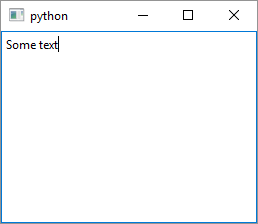Main Window’s Central Widget

1
2
3
4
5
6
7
8
9
10
11
12
13
14
15
16
17
18
19
20
21
22
23
24
25
26
27
28
29
30
31
32
33
34
35
36
# QMainWindow has its own layout to which you can add
# QToolBars, QDockWidgets, a QMenuBar, and a QStatusBar.
# The layout has a center area that can be occupied
# by any kind of widget. In this case we use QTextEdit
import sys
from PySide6.QtWidgets import (QApplication, QMainWindow,
QTextEdit)
# 1 - Create a class that inherits QMainWindow
class Editor(QMainWindow):
def __init__(self):
super().__init__()
# 2 - Create a widget
text_edit = QTextEdit()
# 3 - Set the widget as QMainWindow central widget
self.setCentralWidget(text_edit)
if __name__ == '__main__':
app = QApplication(sys.argv)
editor = Editor()
editor.show()
sys.exit(app.exec())
The QMainWindow class provides support for the following UI elements out of the box:
- Toolbars
- Dock widgets
- Menu bars
- A status bar
and is a good starting point for making complex user interfaces. To use it in your application
-
Create a class that inherits
QMainWindow. In the example the child class name isEditoras the example will be used to make a rudimantary text editor. -
In the
Editor__init__method create to be used as its central widget,QTextEditin the example. -
Set the created
QTextEditobject as the editor’s central widget usingQMainWindow.setCentralWidget()
Now, if you run the example you’ll see a Qt window filled with the text widget.